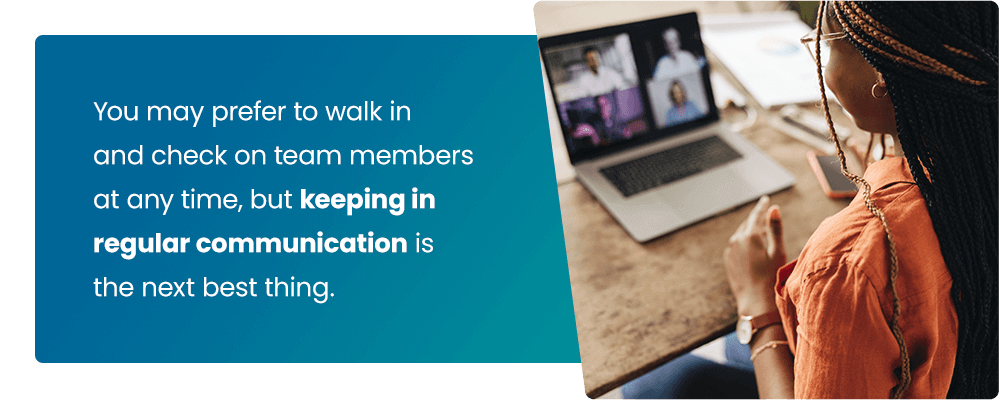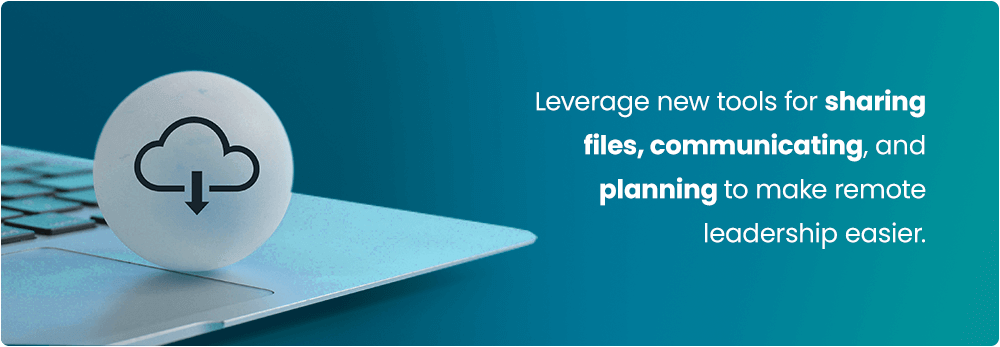Switching to a remote work environment can be a change for managers. This is especially true if you are the type of manager who subscribes to the approach of MBWA (management by walking around). It’s a lot harder to check in on employees and their work progress at any time if they are miles away.
Still, the benefits of remote work are worth the effort of adapting your management style. And as we’ve seen, organizations can be forced into a remote environment at a moment’s notice.
Do differences exist between in-office and remote work environments? Yes. Can managers be successful in both? Absolutely.
Following these tips can enable effective leadership in a remote work environment. While different than MBWA, you may find ways to be an even better manager for a remote team.
Engage with your workers daily
Just because you aren’t in the same building with your employees doesn’t mean that you cannot engage with them on a regular basis. You may prefer to walk in and check on team members at any time, but keeping in regular communication is the next best thing.
You can, and should, use a variety of methods to communicate. A quick email every day to check on progress or to see how they are doing can be enough to keep the employee engaged. Occasional instant messaging and videoconferencing is even more effective form of communication.

Focus on the results, not the process
The previous tip softened the blow of not being able to manage by walking around, but this one will be a little more difficult for managers who prefer a more hands-on approach. One of the productivity-boosting aspects of working at home is that employees can spread work out over the course of a day.
Distractions that happen in the office take time out of an employee’s workday. And at home, it may be easier to make up that time. This is why it’s important to focus on results and not activity.
Ensuring that the work is completed by a deadline outweighs the different routes. Hitting monthly or quarterly targets outweighs daily activity.
Remote work may require team members to take different routes. Effective leadership focuses on ensuring everyone arrives at the proper destination.
Allow for flexible work schedules
Increasing focus on results vs activity helps to encourage flexibility. Without the need for physical presence, flexibility is key. Individuals have unique preferences that can improve the output of your organization.
While there will be times that everyone needs to gather for meetings, don’t feel the need to force your employees to work the same 9 to 5. Have an early bird that likes to start early? Encourage them to work from 7 to 3. Have you been a fitness fanatic that enjoys a mid-day workout? Encourage them to take an appropriate break.
Understanding your team, and their preferences are critical to effective leadership in a remote work environment. Learn the ways your team is most effective and build a system that will support their success.
Build and maintain a company culture
A key factor in how well a team works together is how much they enjoy their organization’s culture. Every company has some level of culture. This includes fun items, like happy hours, but also helps drive how teams interact.
Culture helps an individual’s attitude toward project management. It impacts how disagreements should be handled. And it helps define the vision for the types of products and services that they provide.
It is important for any company to share a culture and values. Instill strong values into employees and foster the continued belief in culture when managing a remote team. Because you can’t pop in on remote workers as frequently as you’d like, you need confidence that they are on the same page.
Hire good remote work candidates
One of the advantages of managing by walking around is that you can enforce a company culture. You are able to motivate employees that might need an extra push to step up their game and get the job done. Absent the ability to do that, you’ll need to focus on hiring employees that are going to be able to do it on their own.
Look for candidates that already have the same value system as your company and who show a high degree of self-motivation. These individuals are more likely to match the company culture and work towards team goals without the need for micro-management.

Make frequent use of videoconferencing
Email and instant messaging are a great fit for remote workers because those things can be more easily fit into the worker’s schedule. But they lack the personal connection that seeing and hearing each other brings to the relationship of a team.
Leverage video conferencing to connect with your employees on a deeper level than just words they see or hear. Being able to see the reactions and tone of individuals can help identify the happiness and motivation of the team. Additionally, leveraging video chat can help increase engagement during meetings and conversations.
Have occasional in-person meetings
Video conferencing is a suitable substitute for in-person meetings when you have no other option. If your employees are working remotely, then this is the case most of the time. Having them come in every time the whole team needs to get together would defeat the purpose of having them work remotely.
When possible, take the opportunity to meet in person. Conducting occasional in-person meetings is an important part of making real, human connections. Just like videoconferencing will build closer bonds than instant messaging, in-person meetings will improve upon video meetings. Face-to-face meetings will encourage small talk and socializing that allow people to grow closer as a team.
Have the right technology
Working remotely requires special technology, software, and tools to help maintain effectiveness. With these tips and the right tech stack, your team can even be more effective while working remotely.

Leverage new tools for sharing files, communicating, and planning to make remote leadership easier.
At AchieveIt, we are focused on making remote work easy. It shouldn’t take an army or tons of manual effort to track the progress of your organization’s most important plans and initiatives. Through a centralized platform, everyone will be connected and accountable to individual, team, and organizational goals. Make it easy for your organization to monitor the progress of initiatives and keep everyone engaged in the organization’s successes.
About AchieveIt
AchieveIt is the platform that large organizations use to get their biggest, most important initiatives out of the boardroom and into reality. Too many great ideas never quite make it across the finish line, because there’s no real way to keep everyone on course and keep everything on track. What does it take to actually guide these initiatives all the way through to completion? You’ve got to:
- Get everything in view – so you can see what’s happening with every initiative, at every level, from the enterprise to the individual, in real time.
- Get everyone engaged – with an easy-to-use platform that connects your organization from the executive leadership to the project teams, keeping everyone accountable and on the same page.
- Get every possible advantage – not only because you have the premier platform in this space, but because you can draw on the experience and best practices of our execution experts.
That’s why everyone from global corporations, to regional healthcare systems, to federal agencies have turned to AchieveIt for their Integrated Plan Management. Let’s actually do this.
Ready to improve your plan execution?
Organizations of all types leverage AchieveIt to manage, execute, and connect their most important initiatives. Replace manual processes & siloed systems with interconnected plans in a single, automated platform.



